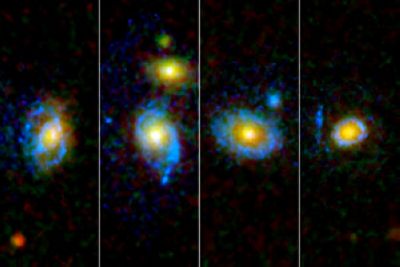Our knowledge and understanding of the cold gas in galaxies remains incomplete. Scientists at the Max Planck Institute for Astrophysics have now developed a new method to stack data from several hundred galaxies so that information about gas content can be extracted for galaxies that are difficult to detect individually. In their analysis, the researchers found that even old, elliptical galaxies still contain a disk of gas that occasionally lights up with young stars.
For technological reasons, studies of the cold neutral gas in galaxies have lagged far behind studies of the stars in galaxies. Stars emit radiation at optical wavelengths, but cold hydrogen gas in atomic form (HI) emits radiation at a wavelength of 21 cm and is only detectable at radio wavelengths.
The last decade has seen renewed efforts to carry out HI surveys over large areas of the sky using existing radio telescopes. The Arecibo Legacy Fast ALFA (ALFALFA) survey is the most advanced of these. When complete, ALFALFA will have detected more than 30,000 extragalactic HI line sources. However, ALFALFA is still shallow compared to state-of-the-art optical galaxy surveys, such as the Sloan Digital Sky Survey. As a result, most of the galaxies detected in such surveys are late-type spiral and irregular galaxies. Rather little is known about cold gas in early-type elliptical and lenticular galaxies.

Interestingly, the mean HI mass fraction does not drop below two per cent, even in the most massive and red elliptical galaxies. One question is whether this gas is associated with the central spheroidal component of the galaxy, or is spread over large radii in a disk or a ring. The 4 arc minute Arecibo beam means that the location of the gas is not known, but the MPA scientists used statistical techniques to argue that the gas is not associated with the central spheroid, but must be located in a disk. Interestingly, a population of elliptical galaxies with outer rings of star formation has now been identified by the Hubble Space Telescope . Taken together, these observations suggest that elliptical galaxies do occasionally accrete gas from the external environment and form new stars.
See the website for more details:http://www.mpa-garching.mpg.de/mpa/research/current_research/hl2012-4/hl2012-4-en.html (SY)
